Buxus microphylla var. japonica 'Unraveled'
weeping Japanese boxwood
Boxwood has long been a mainstay of the landscape from the great gardens of Europe to the foundation plantings in neighborhoods across much of the United States. The genus is much more widespread than is generally known with about 75 to 105 species depending on your taxonomist of choice. The species are mostly tropical with concentrations in three main spots—across western and southern Europe to southern and Eastern Asia, Madagascar and Africa, and Mexico to the northern parts of South America. All species are evergreen shrubs and trees.
Almost all boxwoods in cultivation in the temperate zone are from the European and some Asian species, with the vast majority of landscape plants being selections of Buxus sempervirens. This species enjoys a relatively wide natural range from southwestern and west central Europe to west Asia and around the Mediterranean including northwest Africa. Common boxwood, as it is known, makes a multi-stemmed evergreen shrub or tree which can grow to over 25' tall in the wild if left unpruned. The small leaves give boxwood a fine texture and the wood is extremely dense and durable and so has been used for musical instruments, small boxes, and for woodcut printing. The wood is actually so dense that it is one of the few types which will sink in water.
Boxwoods are used often for their formality in symmetrical foundation plantings and as formal hedges and parterres. The selection 'Unraveled' from the plantsmen at Yucca Do Nursery in Texas takes an abrupt departure from its buttoned-down relatives. Instead of forming an upright oval, it arches and cascades down for an elegant but very different effect. Unlike the old selections of weeping or pendulous boxwoods which were more irregular with drooping tips, 'Unraveled' is a true weeping plant.
Specimens of the lovely Buxus microphylla var. japonica 'Unraveled' can be staked up with a central leader and allowed to form a small, weeping tree or allowed to grow as they will forming a spreading shrub 4' tall by about 7' wide. The plant makes an outstanding four season specimen flanking a doorway or growing in a decorative pot but can also be used in mass on a dry hillside or cascading over a wall. It can also be used much like a traditional boxwood but will give a softer, less formal appearance which fits in well with modern landscapes.
Boxwoods are often placed in full sun situations but are actually quite happy growing in shade, even in hard-to-landscape dry shady spots. While 'Unraveled' will tolerate heavy shearing, it is best to only trim out errant branches and to prune to enhance the graceful character of the plant. Keep new plants watered to get them established but after the first couple of years, boxwoods will tolerate significant drought especially in some shade. 'Unraveled' has proven to be relatively pest and disease resistant and should be a long-lived, all-season specimen in the garden.
Additional Resources
Mark Weathington, director, discussed Buxus microphylla var. japonica 'Unraveled' in his
"Bullet Proof Trees and Shrubs for the South" Gardening in the South presentation on February 1, 2020.
Additional photographs of Buxus microphylla var. japonica 'Unraveled' can be found in the JCRA's Photograph Collection.

